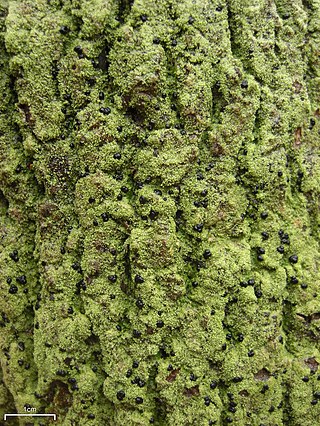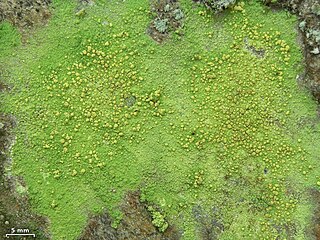
Bacidina is a genus of lichens in the family Ramalinaceae. It was circumscribed by Czech lichenologist Antonín Vězda in 1990, with Bacidina phacodes assigned as the type species. Vězda included 11 species in Bacidina, which was originally classified in the Lecideaceae. These species had previously been placed in genus Bacidia.

Bacidia is a genus of lichen-forming fungi in the family Ramalinaceae. The genus was circumscribed by Giuseppe De Notaris in 1846. Species in the genus are crust-like lichens with stemless apothecia; they have green algae (chloroccoid) as photobionts. Their asci have 8 colorless, cylindrical to acicular, multiseptate spores, with curved and thread-like conidia.
Crustospathula is a genus of five species of crustose lichens in the family Malmideaceae. They are characterized by their stalked and sometimes branched cartilaginous soredia and Bacidia-like apothecia.

Micarea is a genus of lichenized fungi in the family Pilocarpaceae. The widely distributed genus contains 126 species and new species are described actively. Species in the genus are crustose lichens and their photobiont is a single-celled green alga.
Agonimia is a genus of lichen-forming fungi in the family Verrucariaceae.

Pilophorus acicularis, commonly known as the nail lichen or the devil's matchstick lichen, is a species of matchstick lichen in the family Cladoniaceae.

Lecanora polytropa, commonly known as the granite-speck rim lichen, is a species of saxicolous lichen in the family Parmeliaceae. A small, inconspicuous species that grows in the cracks of rock surfaces, it has a cosmopolitan distribution and has been recorded on all continents, including Antarctica.

Psilolechia lucida is a species of saxicolous lichen in the family Psilolechiaceae. It is widely distributed through the world, where it grows on natural and artificial rocky substrates in the shade, often in sheltered underhangs. It forms a greenish crust on the surface of its substrate.
Atrophysma is a genus in the family Pannariaceae. It contains the single species Atrophysma cyanomelanos, a crustose lichen found only in Alaska.
Waynea cretica is a species of corticolous (bark-dwelling), squamulose lichen in the family Ramalinaceae. It occurs on the Greek island of Crete and in Portugal.
Micarea pauli is a species of corticolous and lignicolous, crustose lichen in the family Pilocarpaceae. It is only known to occur in Poland's Białowieża Forest.
Bacidina mendax is a species of corticolous (bark-dwelling) lichen in the family Ramalinaceae. It is found in Central and Eastern Europe, where it grows on the bark of twigs and tree branches.
Bacidina flavoleprosa is a species of saxicolous (rock-dwelling), leprose (powdery) lichen in the family Ramalinaceae. It is found in a single locality in the Czech Republic.
Heteroplacidium zamenhofianum is a species of lichenicolous (lichen-eating) lichen in the family Verrucariaceae. As a juvenile, it is parasitic on some members of the lichen genus Staurothele, but later becomes independent and develops a brown, crustose thallus. Characteristic features of the lichen include its dark brown, somewhat squamulous thallus and relatively small ascospores. It is widely distributed in Europe and North America.
Buelliella lecanorae is a species of lichenicolous (lichen-eating) fungus in the class Dothideomycetes. It is found in a few locations in Estonia and in Crimea, where it grows parasitically on members of the Lecanora subfusca species group.
Opegrapha verseghyklarae is a little-known species of lichenicolous (lichen-eating) fungus in the family Teloschistaceae. It is found in the Russian Far East, where it grows on the thalli and apothecia of the crustose lichen Ochrolechia pallescens.
Lecidella mandshurica is a species of corticolous (bark-dwelling), crustose lichen in the family Lecanoraceae. It is found in the Russian Far East, South Korea, and China.
Agonimia flabelliformis is a species of corticolous (bark-dwelling) lichen in the family Verrucariaceae. Found in Europe, it was scientifically described as new to science in 2011 by Josef Halda, Paweł Czarnota, and Beata Guzow-Krzemińska. The type specimen was collected in the Gratzen Mountains at an altitude of 805 m (2,641 ft), where it was found growing on the bark of a beech tree. The thallus of the lichen consists of finger-like (dactyliform) to coral-like (coralloid) aggregations of goniocys]s that form a roundish structure. The species epithet flabelliformis refers to the fan-shaped (flabellate) form of the thallus branches. In addition to Europe, the lichen has also been recorded in eastern North America and the Russian Far East.
Tephromela lignicola is a species of lignicolous (wood-dwelling), crustose lichen in the family Tephromelataceae. It is found in the Falkland Islands, where it grows on fenceposts and similar timber.

Dirina fallax is a species of saxicolous (rock-dwelling), crustose lichen in the family Roccellaceae. It is found in the western Mediterranean, the Atlantic coasts of both Africa and Europe, and central Europe, where it grows on siliceous and acidic rocks. In 2017, it was reported from the Abrau Peninsula in Russia.








